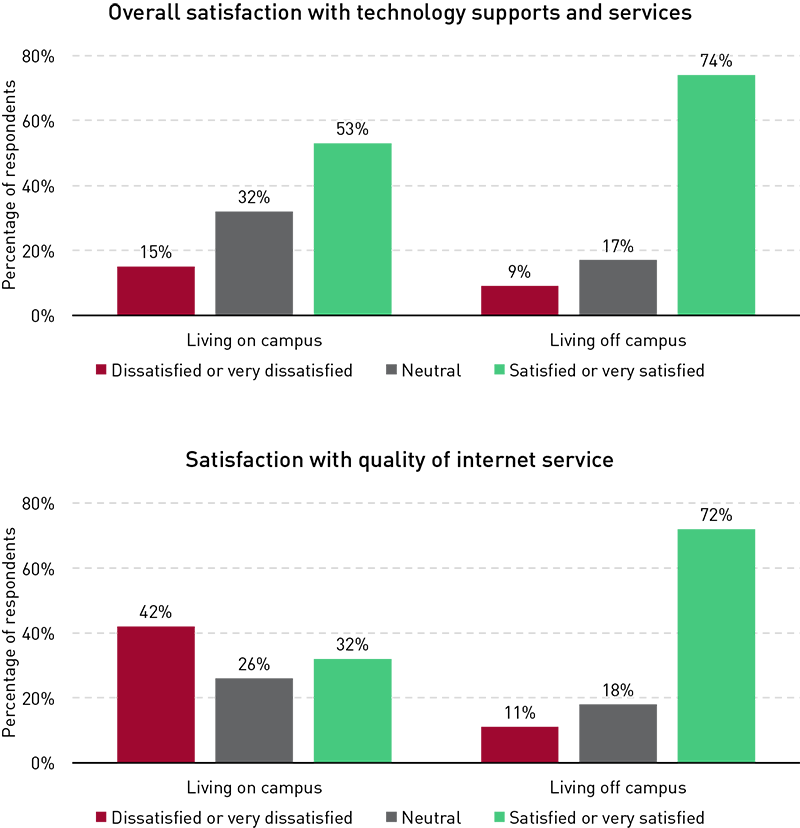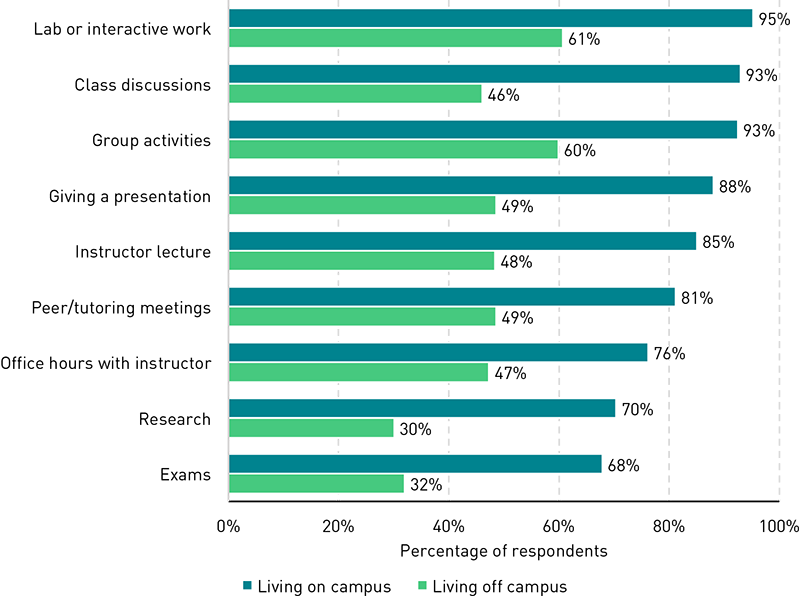Supporting Students On and Off Campus
Many institutions of higher education have long thrived on serving students who reside in campus dormitories or campus-provided housing. The "college dorm room" is ingrained in our collective cultural ideas about what a "typical" college experience includes, as spaces most often inhabited by young adults fresh out of high school and just embarking on their journey of self-discovery and adulthood.
These students will surely continue to be a key demographic for many institutions in the future, though declining birth rates, a looming enrollment cliff, and growing doubts among the general population about the value of this "typical" college experience will likely see this segment of students become a less reliable source of enrollments and revenues than they have been in years past.
We know, of course, that many students experience higher education from places and spaces that are far different from the campus dorm room. A growing number of adult learners are returning to (or just beginning) their degree programs, for example, to reskill or completely reset their careers in response to larger economic and workforce trends. Other students for whom four-year, residential degree programs are simply infeasible (and even unnecessary) may instead be seeking microcredentialing opportunities or flexible workplace education programs.
For these and many other students, life is happening not in the college dorm room but in their own homes surrounded by their kids' toys and in between busy work hours. Where enrollments among younger residential student populations may be declining, opportunities to tap into the educational needs of these lifelong and off-campus learners may yet be fertile ground for institutions seeking to rethink and adapt their business models for the future.
Internet as a Location-Based Amenity
We begin with a deceptively simple but vitally important aspect of the lived experiences of our postsecondary students: the internet. The internet has become a ubiquitous and essential tool for students in accessing course materials, communicating with their instructors and other students, and participating in class activities. The internet is also a very place-based resource that ebbs and flows in quality across regions, communities, buildings, and even from one room to the next. Being both vitally important and locationally variable, the internet is and will continue to be one of the most desirable and essential amenities for students in their housing accommodation choices.
Confirming this notion of locational variability, our survey finds that student satisfaction with the quality of institutional internet service varies significantly across different student living arrangements. By a wide margin, students living off campus are more satisfied with the quality of their institution's internet service, compared with students living on campus, in addition to being more satisfied with their institution's overall technology services and support (see figure 1).1

When asked to further explain what their institution could do to improve their overall technology services and supports, the overwhelming majority of student comments focused on internet connectivity and quality.
"We need decent wifi [in our library]. As a quiet study space, it provides a place where I can finally study in peace, but the wifi situation is appalling. When there are several people studying up here, I can barely connect to the internet."
"The wifi is terrible—fix the wifi. It shouldn't be so hard to connect to the wifi in a massive lecture hall for a class that expects you to have access to the internet."
"I think mostly things are fine. I am just very annoyed sometimes when semi-often the internet goes out on a campus-wide scale where no one can access the internet."
So what? As consumers who will increasingly have a choice between existing residential degree programs and emerging, locationally flexible programs, students will view connectivity as one of the most critical factors influencing that choice. For students living on campus in particular, the internet is an amenity needed for recreational purposes around the edges of their student work—for activities like online gaming and streaming movies—that are also more likely to expose limitations in internet connectivity and bandwidth. Institutions that fail to sufficiently buttress this aspect of the student experience may see more students choosing to make their home elsewhere.
Learning Modality as a Lifestyle Preference
Residential choices are driven by life circumstances and preferences, and so too are learning modality choices. Students living off campus were far more likely than on-campus students to report being married, having dependents, and being employed, all factors that would heighten the appeal of remote and/or flexible course engagement options that fit better with the demands and busyness of their home lives.
Students living on campus, on the other hand, were more likely to evince a social connectedness with other students (e.g., talking with other students about both academic and personal matters), a factor that would heighten the appeal of in-person, on-site course engagement options that they might perceive as conducive to interacting with their peers.
Not surprisingly, then, students living off campus were significantly less likely to prefer on-site modes of course engagement compared with their peers who live on campus (see figure 2). With the exception of labs or interactive work and group activities (course activities that in many cases are more suitable for in-person engagement), a majority of students living off campus reported a preference for online modalities.

Conversely, students living on campus overwhelmingly expressed a preference for on-site modalities for all of the same course activities. Even the lowest rated activity among these students, exams, is still preferred as an on-site activity by a full 68% of students living on campus, compared with only 32% of students living off campus.
So what? Higher education leaders and decision makers may wish (and need) to have more "sophisticated" discussions around learning modalities—which modalities result in better learning outcomes, or which modalities are more conducive to the kinds of learning experiences they want to design for students? But for students themselves, modality preferences are tied to much more immediate considerations around lifestyle and convenience. It's at least as much a pragmatic question than a theoretical one. It is increasingly important, then, to understand who our students are, where they are, and what they need, particularly as the who's and where's and what's of the student population evolve and look less and less like the student populations of the past.
Hybrid Course Experiences
As students increasingly come to view learning modalities through their own life circumstances and personal preferences, their overall engagement and satisfaction with their courses will also increasingly be driven by the degree to which course design does or does not conform to those circumstances and preferences.
A Note on Modality Terminology & Practice
At EDUCAUSE, we recognize that higher education stakeholders have not come to a consensus on the way instructional modalities are labeled and operationalized. People have different definitions and understandings of courses that are labeled as "online," "online synchronous," "online asynchronous," "hybrid," "blended," "HyFlex," and "in-person." While it was beyond the scope of this study to perform a deep dive into the nuances of modalities, we felt that it was important to assess the extent to which instructional modalities included online or on-site and synchronous or asynchronous components, and whether technology is used to support teaching and learning. Throughout the report, we use the terms "on-site" to describe courses that take place on-campus (aka, in-person or face-to-face), "online" to describe activities that take place remotely, and "hybrid" as shorthand for the types of courses that accommodate some degree and combination of these different ways of engaging.
Students who reported enrolling in at least one hybrid course over the past academic year were asked to indicate the mode in which they most typically engage in that course—online or on-site. Students living off campus were significantly more likely to engage in their hybrid course online (53% said they "mostly" or "only" participate online) compared with students living on campus (29% said they "mostly" or "only" participate online).
Students' overall assessments of their hybrid course experiences aligned with these differences as well. Among students living off campus (n = 461)—students we might reasonably assume would benefit more from the options and flexibility some hybrid courses offer—69% reported being satisfied or very satisfied with their hybrid course experience. In contrast, among students living on campus (n = 121), only 54% reported being satisfied with their hybrid course experience.
As one possible explanation for these differences in satisfaction in particular, we might consider what these two different groups of students might be gaining or losing from hybrid course models as they currently exist. Students who require more flexibility and accommodation in their daily lives, and who therefore tend to prefer more online modes of engagement, clearly benefit from and would likely be more satisfied with the greater flexibility and additional options of hybridity. On the other hand, students who are already on campus and who tend to prefer more on-site engagements are in the position of having to adjust, at least for some activities, to additional (and less desirable) online modes of engagement.
Indeed, student comments about their hybrid course experiences highlighted these frustrations, particularly among students who prefer on-site experiences:
"I'd just rather it be an in-person class. It is a discussion-based class with a small group of about 9 students, and it would be so much more beneficial to get to know those people by talking with them in person instead of having to use zoom."
"With hybrid courses, we are technically taking home 2.5h of homework each week. It would be nice if the administration changed what defined a hybrid course and allowed for more time in a class, even if there are less students in the classroom."
"Felt like most of my learning came online, and I prefer to learn in person and then do classwork at home, but it felt like it was mostly online."
So what? Certain course designs impact students differently, particularly along areas of lifestyle and life circumstances. As institutions experiment with hybrid, HyFlex, and other course models, they will need to balance competing needs and preferences among an increasingly diverse and evolving student population. There may be at least one promising approach to this balancing act: providing options and empowering students to choose, an approach to which we now turn.
Note
-
Percentages throughout have been rounded to the nearest whole number, occasionally resulting in sums just under or over 100%.
↩︎